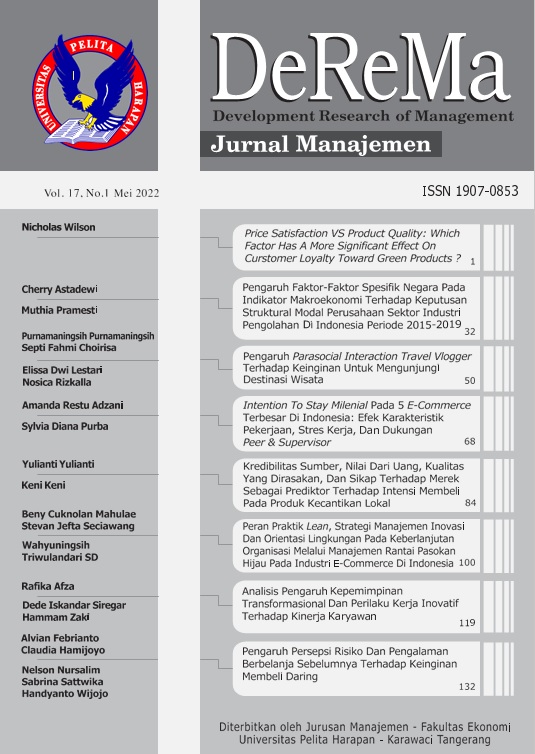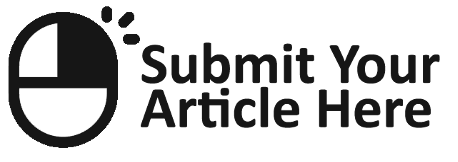Pengaruh Parasocial Interaction Dari Travel Vlogger Terhadap Keinginan Untuk Mengunjungi Destinasi Wisata [The Effect of Parasocial Interaction from Travel Vloggers on Desire to Visit Tourist Destinations]
DOI:
https://doi.org/10.19166/derema.v17i1.4247Λέξεις-κλειδιά:
parasocial interaction, attractiveness, intention to visitΠερίληψη
Tourism is a growing industry in Indonesia. In early 2019, the government established super priority destinations that are expected to enhance the number of tourist visits to Indonesia. However, the increase of a tourist destination to a super priority destination has some challenges in some areas, as some tourists simply fail their trip because of the fairly high entrance costs on the super priority tourist destination, this of course makes the number of tourists visiting decrease. In addition, the pandemic of covid in early 2020 also caused many tourists to cancel their visit to Indonesia. Therefore, the study aims to enhance the number of tourist visits in Indonesia through reviews from travel vloggers on YouTube. This research wants to see what factors can drive the desire of tourists to visit through the approach of parasocial interaction that is the relationship between subscriber and travel vlogger. The study tested 4 hypotheses with the analysis of the Structural Equation Model (SEM). The results of this study indicate that attitudes of homophily and physical attractiveness have a positive effect on parasocial interaction, which will then affect intention to visit. Social attractiveness in this study has not been shown to have an effect on parasocial interaction. The managerial implications of this research related to tourism will be explored in depth.
Bahasa Indonesia Abstrak: Pariwisata merupakan industri yang sedang berkembang di Indonesia. Pada awal 2019 pemerintah menetapkan destinasi superpriortas yang diharapkan dapat meningkatkan jumlah kunjungan wisatawan di Indonesia. Namun demikian, peningkatan sebuah destinasi wisata menjadi destinasi superprioritas memiliki beberapa tantangan di beberapa daerah, seperti beberapa wisatawan justru menggagalkan perjalananya karena biaya masuk yang cukup tinggi pada destinasi wisata superprioritas tersebut, hal ini tentu saja membuat jumlah wisatawan yang berkunjung menurun. Selain itu, adanya pandemic covid diawal tahun 2020 juga membuat banyak wisatawan membatalkan kunjungannya ke Indonesia. Oleh karena itu, penelitian ini bertujuan untuk meningkatkan jumlah kunjungan wisata di Indonesia melalui ulasan dari travel vlogger di Youtube. Penelitian ini ingin melihat faktor apa saja yang dapat mendorong keinginan wisatawan untuk berkunjung melalui pendekatan parasocial interaction yaitu hubungan yang terjalin antara subscriber dan travel vlogger. Penelitian ini menguji 4 hipotesis dengan analisis Structural Equation Model (SEM). Hasil dari penelitian ini menunjukan bahwa attitude homophily dan physical attractiveness memiliki pengaruh positif terhadap parasocial interaction, yang kemudian akan mempengaruhi intention to visit. Sedangkan social attractiveness pada penelitian ini tidak terbukti berpengaruh terhadap parasocial interaction. Implikasi manajerial penelitian ini terkait pariwisata akan dijelaksan secara mendalam.
Αναφορές
Alghizzawi, M., Salloum, S. A., & Habes, M. (2018). The role of social media in tourism marketing in Jordan. International Journal of Information Technology and Language Studies, 2(3), 59-70.
Auter, P. J., & Palmgreen, P. (2000). Development and validation of a parasocial interaction measure: The audience”persona interaction scale. Communication Research Reports, 17(1), 79-89. https://doi.org/10.1080/08824090009388753
Al Hafiz, M. P. (2019, July 11). Memahami Lima Karakter Traveler Milenia. Retrieved from https://marketeers.com/memahami-lima-karakter-traveler-milenial/
Ay, E., İpek, K., Özdağ, N. B., Özekici, E., & Alvarez, M. D. (2019). Travel Bloggers as Influencers: What Compels Them to Blog. In Tourist Destination Management, 9, 159-175. https://doi.org/10.1007/978-3-030-16981-7_9
CNNIndonesia (2020, February 26). Menghitung Kontribusi Sektor Pariwisata Bagi RI. Retrieved from https://www.cnnindonesia.com/ekonomi/20200226121314-532-478265/menghitung-kontribusi-sektor-pariwisata-bagi-ekonomi-ri
Chen, Y. C., Shang, R. A., & Li, M. J. (2014). The effects of perceived rele vance of travel blogs’ content on the behavioral intention to visit a tourist destination. Computers in Human Behavior, 30, 787-799. https://doi.org/10.1016/j.chb.2013.05.019
Choirisa, S. F., Purnamaningsih, P., & Alexandra, Y. (2021). The Effect Of E-Wom On Destination Image And Attitude Towards To The Visit Intention In Komodo National Park, Indonesia. Journal of Tourism Destination and Attraction, 9(1), 49-60. https://doi.org/10.35814/tourism.v9i1.1876
Choirisa, S. F., & Purnamaningsih, Y. A. (2020). Examining the Theory Planned Behavior to Wildlife Tourism. In Culture, People and Technology: The Driving Forces for Tourism Cities Proceedings of 8th ITSA Biennial Conference 2020 (p. 59).
Djafarova, E., & Rushworth, C. (2017). Exploring the credibility of online celebrities' Instagram profiles in influencing the purchase decisions of young female users. Computers in Human Behavior, 68, 1-7. https://doi.org/10.1016/j.chb.2016.11.009
Editorm2 (2020, October 7). Membangun Pariwisata Premium Berkelanjutan Berbasis Masyarakat. Retrieved from https://matanews.net/2020/10/07/membangunan- pariwisata-premium-berkelanjutan-berbasis-masyarakat/
Egeham, L. (2019, July 11). Jokowi Akan Buat Pulau Komodo Lebih Eksklusif. Retrieved from https://www.liputan6.com/news/read/4010244/jokowi-akan-buat-pulau-komodo-lebih-eksklusif
Endarwati, O. (2020, January 16). Kemenparekraf Kejar Penyelesaian Infrastruktur 5 Destinasi Prioritas di 2020. Retrieved from https://ekbis.sindonews.com/read/1498801/34/kemenparekraf-kejar-penyelesaian- infrastruktur-5-destinasi-prioritas-di-2020-1579171973
Eyal, K., & Rubin, A. M. (2003). Viewer aggression and homophily, identification, and parasocial relationships with television characters. Journal of Broadcasting & Electronic Media, 47(1), 77-98. https://doi.org/10.1207/s15506878jobem4701_5
Fu, H., Ye, B. H., & Xiang, J. (2016). Reality TV, audience travel intentions, and destination image. Tourism Management, 55, 37-48. https://doi.org/10.1016/j.tourman.2016.01.009
Gleason, T. R., Theran, S. A., & Newberg, E. M. (2017). Parasocial interactions and relationships in early adolescence. Frontiers in Psychology, 8, 255. https://doi.org/10.3389/fpsyg.2017.00255
Haobin Ye, B., Fong, L. H. N., & Luo, J. M. (2021). Parasocial interaction on tourism companies’ social media sites: Antecedents and consequences. Current Issues in Tourism, 24(8), 1093-1108. https://doi.org/10.1080/13683500.2020.1764915
Hair, J. F., Black, W. C., Babin, B. J., & Anderson, R. E. (2010). Multivariate Data Analysis (7th ed.). Pearson Prentice Hall.
Hays, S., Page, S. J., & Buhalis, D. (2013). Social media as a destination marketing tool: Its use by national tourism organisations. Current Issues in Tourism, 16(3), 211-239. https://doi.org/10.1080/13683500.2012.662215
Horton, D., & Wohl, R. R. (1956). Mass communication and para-social interaction: Observations on intimacy at a distance. Psychiatry,19, 215-229. https://doi.org/10.1080/00332747.1956.11023049
Hsu, C. L. (2020). How vloggers embrace their viewers: Focusing on the roles of para- social interactions and flow experience. Telematics and Informatics, 49, 101364. https://doi.org/10.1016/j.tele.2020.101364
Huang, C. Y., Chou, C. J., & Lin, P. C. (2010). Involvement theory in constructing bloggers' intention to purchase travel products. Tourism Management, 31(4), 513-526. https://doi.org/10.1016/j.tourman.2009.06.003
Hudson, S., & Thal, K. (2013). The impact of social media on the consumer decision process: Implications for tourism marketing. Journal of Travel & Tourism Marketing, 30(1-2), 156-160. https://doi.org/10.1080/10548408.2013.751276
Huertas, A., MÃguez-González, M. I., & Lozano-Monterrubio, N. (2017). YouTube usage by Spanish tourist destinations as a tool to communicate their identities and brands. Journal of Brand Management, 24(3), 211-229. https://doi.org/10.1057/s41262-017-0031-y
Hwang, K., & Zhang, Q. (2018). Influence of parasocial relationship between digital celebrities and their followers on followers’ purchase and electronic word-of-mouth intentions, and persuasion knowledge. Computers in Human Behavior, 87, 155-173. https://doi.org/10.1016/j.chb.2018.05.029
Kemenpar (2019, December 10). Data Kunjungan Wisatwan Mancenegara Bulanan Tahun 2019. Retrieved from https://www.kemenpar.go.id/post/data-kunjungan-wisatawan- mancanegara-bulanan-tahun-2019
Kemenparekraf (2019, September 10). Siaran Pers: Rakornas Pariwisata III Bahas Pengembangan 5 Destinasi Super Prioritas. Retrieved from https://www.kemenparekraf.go.id/post/siaran-pers-rakornas-pariwisata-iii-bahas-pegembangan-5-destinasi-super-prioritas#:~:text=Kelima%20destinasi%20super%20prioritas%20tersebut,serta%20d ipromosikan%20secara%20masif%20setelahnya
Khoiri, A. M. (2019, October 6). Wacana Tiket Rp 14 Juta, Sudah Ada Turis Batal ke Pulau Komodo. Retrieved from https://travel.detik.com/travel-news/d-4735384/wacana-tiket-rp-14-juta-sudah-ada-turis-batal-ke-pulau-komodo
Kiráľová, A., & PavlÃÄeka, A. (2015). Development of social media strategies in tourism destination. Procedia-Social and Behavioral Sciences, 175, 358-366. https://doi.org/10.1016/j.sbspro.2015.01.1211
Knoll, J., Schramm, H., Schallhorn, C., & Wynistorf, S. (2015). Good guy vs. bad guy: the influence of parasocial interactions with media characters on brand placement effects. International Journal of Advertising, 34(5), 720-743. https://doi.org/10.1080/02650487.2015.1009350
Kurniawan, S. S. (2020, September 16). Duh, Sektor Pariwisata Global Kehilangan Rp 6.800 Triliun Akibat Pandemi Virus Corona. Retrieved from https://internasional.kontan.co.id/news/duh-sektor-pariwisata-global-kehilangan-rp-6800-triliun-akibat-pandemi-virus-corona
Kurtin, K. S., O'Brien, N., Roy, D., & Dam, L. (2018). The development of parasocial interaction relationships on YouTube. The Journal of Social Media in Society, 7(1), 233-252.
Lee, J. E., & Watkins, B. (2016).YouTube vlogger influence on consumerluxury brand perceptions and intention. Journal of Business Research, 68, 5753-5760. https://doi.org/10.1016/j.jbusres.2016.04.171
Liliyah, A. (2018). Survei Amadeus: Empat Hal yang Disukai Wisatawan Indonesia. Retrieved March 5, 2020, from https://swa.co.id/swa/trends/survei-amadeus-empat-hal-yang-disukai-wisatawan-indonesia
Pan, B., MacLaurin, T., & Crotts, J. C. (2007). Travel blogs and the implications for destination marketing. Journal of Travel Research, 46(1), 35-45. https://doi.org/10.1177/0047287507302378
Park, D. H., & Kim, S. (2008). The effects of consumer knowledge on message processing of electronic word-of-mouth via online consumer reviews. Electronic Commerce Research and Applications, 7(4), 399-410. https://doi.org/10.1016/j.elerap.2007.12.001
Perse, E. M., & Rubin, R. B. (1989). Attribution in social and parasocial relationships. Communication Research, 16(1), 59-77. https://doi.org/10.1177/009365089016001003
Pradhan, D., Duraipandian, I., & Sethi, D. (2016). Celebrity endorsement: How celebrity- brand-user personality congruence affects brand attitude and purchase intention. Journal of Marketing Communications, 22(5), 456-473. https://doi.org/10.1080/13527266.2014.914561
Reino, S., & Hay, B. (2011). The use of YouTube as a tourism marketing tool. In Proceedings of the 42nd Annual Travel & Tourism Research Association Conference, London, Ontario, Canada.
Rihl, A., & Wegener, C. (2017). YouTube celebrities and parasocial interaction: Using feedback channels in mediatized relationships. Convergence, 1354856517736976. https://doi.org/10.1177/1354856517736976
Rubin, R. R., & McHugh, M. P. (1987). Development of para-social interaction relationship. Journal of Broadcasting and Electronic Media, 31(3), 213-222. https://doi.org/10.1080/08838158709386664
Saldanha, N., Mulye, R., & Rahman, K. (2018). Who is the attached endorser? An examination of the attachment-endorsement spectrum. Journal of Retailing and Consumer Services, 43, 242-250. https://doi.org/10.1016/j.jretconser.2018.04.004
Safko, L. (2010). The social media bible: Tactics, tools, and strategies for business success. John Wiley & Sons.
Schramm, H., & Hartmann, T. (2008). The PSI-Process Scales. A new measure to assess the intensity and breadth of parasocial processes. Communications, 33(4), 385- 401. https://doi.org/10.1515/COMM.2008.025
Sokolova, K., & Kefi, H. (2019). Instagram and YouTube bloggers promote it, why should I buy? How credibility and parasocial interaction influence purchase intentions. Journal of Retailing and Consumer Services, 53, 101742. https://doi.org/10.1016/j.jretconser.2019.01.011
Su, H. J., Huang, Y. A., Brodowsky, G., & Kim, H. J. (2011). The impact of product placement on TV-induced tourism: Korean TV dramas and Taiwanese viewers. Tourism Management, 32(4), 805-814. https://doi.org/10.1016/j.tourman.2010.06.020
Todorov, A., & Uleman, J. S. (2002). Spontaneous trait inferences are bound to actors' faces: Evidence from a false recognition paradigm. Journal of Personality and Social Psychology, 83(5), 1051. https://doi.org/10.1037/0022-3514.83.5.1051
Wenger, A. (2008). Analysis of travel bloggers' characteristics and their communication about Austria as a tourism destination. Journal of Vacation Marketing, 14(2), 169- 176. https://doi.org/10.1177/1356766707087525
Yulianto, A. (June, 2020). Ini Imbas Penurunan Sektor Pariwisata Akibat Covid-19. Retrieved November, 23, 2020, from https://republika.co.id/berita/qcmn68396/ini-imbas-penurunan-sektor-pariwisata-akibat-covid19
Yusendra, M. A. E., & Paramitasari, N. (2018). Identifying factors affecting domestic tourist satisfaction on tourist destinations in indonesia. DeReMa Jurnal Manajemen, 13(2), 157-174. http://dx.doi.org/10.19166/derema.v13i2.792
Zheng, X., Men, J., Xiang, L., & Yang, F. (2020). Role of technology attraction and parasocial interaction in social shopping websites. International Journal of Information Management, 51, 102043. https://doi.org/10.1016/j.ijinfomgt.2019.102043
Zhang, H., Xu, H., & Gursoy, D. (2020). The effect of celebrity endorsement on destination brand love: A comparison of previous visitors and potential tourists. Journal of Destination Marketing & Management, 17, 100454. https://doi.org/10.1016/j.jdmm.2020.100454
Zuhriah, D. A. (2019, September 10). Trend Kenaikan Wisatawan Domestik Di Dominasi Generasi Milenial. Retrieved from https://ekonomi.bisnis.com/read/20190910/12/1146575/tren-kenaikan-wisatawan-domestik-didominasi-generasi-milenial
Λήψεις
Δημοσιευμένα
Τεύχος
Ενότητα
Άδεια
Authors who publish with this journal agree to the following terms:
1) Authors retain copyright and grant the journal right of first publication with the work simultaneously licensed under a Creative Commons Attribution License (CC-BY-SA 4.0) that allows others to share the work with an acknowledgement of the work's authorship and initial publication in this journal.
2) Authors are able to enter into separate, additional contractual arrangements for the non-exclusive distribution of the journal's published version of the work (e.g., post it to an institutional repository or publish it in a book), with an acknowledgement of its initial publication in this journal.
3) Authors are permitted and encouraged to post their work online (e.g., in institutional repositories or on their website). The final published PDF should be used and bibliographic details that credit the publication in this journal should be included.





